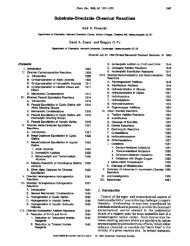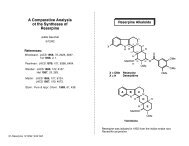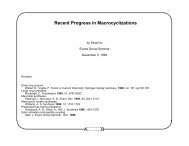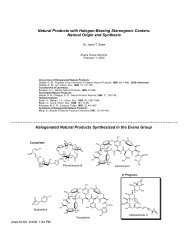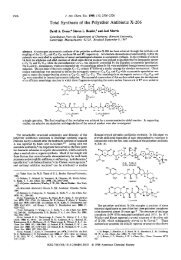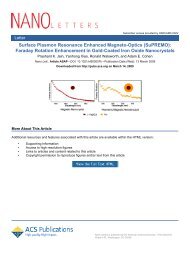8' @Et - Harvard University
8' @Et - Harvard University
8' @Et - Harvard University
You also want an ePaper? Increase the reach of your titles
YUMPU automatically turns print PDFs into web optimized ePapers that Google loves.
9800 J. Am. Chem. SOC. 1993,115, 9800-9801<br />
A Chiral Samarium-Based Catalyst for the Asymmetric<br />
Meenvein-Ponndorf-Verley Reduction<br />
David A. Evans,' Scott G. Nelson, Michel R. Gag&, and<br />
Alexander R. Muci<br />
Department of Chemistry<br />
<strong>Harvard</strong> <strong>University</strong><br />
Cambridge, Massachusetts 021 38<br />
Received July 19, 1993<br />
The Meerwein-Ponndorf-Verley (MPV) reduction enjoys a<br />
prominent historical position in synthesis methodology,' and<br />
milder variants of this process utilizing trivalent lanthanide<br />
catalysts continue to improve the utility of this reaction for the<br />
reduction of ketones.2 The purpose of this communication is to<br />
report an enantioselective variant of the MPV reduction which<br />
is catalyzed by a chiral samarium(II1) complex at ambient<br />
temperatures in 2-propan01.~<br />
On the basis of precedent established by Kagan,2 a range of<br />
Sm(II1) complexes were generated from freshly prepared Sm13<br />
and chiral bi- and tridentate ligands. These complexes were<br />
screened as catalysts in the reduction of o-chloroacetophenone<br />
(25 equiv of 2-propanol, 25 "C) (eq 1). This screening process<br />
Me2CHOH<br />
J<br />
1 Me,C=O 2<br />
revealed two important trends. First, contrary to expectation,<br />
complexed ligands containing chiral secondary alkoxides are not<br />
oxidized under the reaction conditions, an important consideration<br />
in ligand design since secondary alcohols are potential substrates<br />
in this reaction. Second, chiral bidentate ligands consistently<br />
afforded lower enantioselectivities than several tridentate ligand^.^<br />
The most successful of these ligands and the use of the derived<br />
lanthanide complex in asymmetric MPV reductions are reported<br />
in the following discussion.<br />
The ligand (R.R)-3, giving the highest selectivities for the MPV<br />
reduction of aryl methyl ketones, was synthesized in one step<br />
from commercially available (R)-styrene oxide and benzylamine<br />
(eq 2).5 Generation of the 1:l metal-ligand complex 4 was<br />
Bn<br />
0Li 0-Sill-0<br />
I<br />
4 I<br />
accomplished by double deprotonation of (R,R)-3 with hydroxide-<br />
(1) (a) Wilds, A. L. Org. React. (N.Y.) 1944,2, 178-223. (b) Woodward,<br />
R. B.; Wendler, N. L.; Brutschy, F. J. J. Am. Chem. Soc. 1945, 67, 1425-<br />
1429. (c) von E. Doering, W.; Aschner, T. C. J. Am. Chem. SOC. 1953, 75,<br />
393-397.<br />
(2) (a) Namy, J. L.; Souppe, J.; Collin, J.; Kagan, H. B. J. Org. Chem.<br />
1984,49,2045-2049. (b) Lebrun, A.; Namy, J. L.; Kagan, H. B. Tetrahedron<br />
Lett. 1991, 32, 2355-2358.<br />
(3) Limited success has been achieved using chiral Zr, Ru, Rh, and Ir<br />
complexes as catalysts: (a) Zassinovich, G.; Mestroni, G.; Gladiali, S. Chem.<br />
Reu. 1992, 92, 1051-1069 and references cited therein. (b) Scebach, D.;<br />
Plattner, D. A.; Beck, A. K.; Wang, Y. M.; Hunziger, D. Helu. Chim. Acta<br />
1992, 75, 2171-2209.<br />
Table I. Enantioselective MPV Reduction of Aryl Methyl Ketones"<br />
entry substrate % ee (config) % conversionc<br />
OOO2-7863/93/1515-9800$04.00/0 0 1993 American Chemical Society<br />
x = CI 97 (Rjd*e 100 (96)<br />
@Me X=H 96 (md 83 (74)<br />
3 X=OMe 96(R)' 100 (95)<br />
5" d M e<br />
x = CI<br />
X=OMe<br />
94"<br />
92(R)*<br />
91 (88)<br />
43 (36)<br />
6<br />
X<br />
X=NOp 94(R)g 100 (77)<br />
x = CI 68 (mdte 95 (76)<br />
<strong>8'</strong> <strong>@Et</strong> X=H 73 (R)' 66 (63)<br />
'/ /<br />
Me<br />
96 (R) 84 (82)<br />
10 97 (Rf" 98 (95)<br />
(I Reactions were carried out on a 2-mmol scale using the conditions<br />
given in the text. Products were isolated after complete conversion or<br />
24 h. Absoluteconfiguration assigned by comparisonof product rotations<br />
to literature values except where noted. Conversions were determined<br />
by GLC. Values in parenthesesare isolated yields. Enantiomericpurity<br />
was determined by chiral GLC assay (Chiraldex G-TA). Absolute<br />
configuration was assigned by the method of Trost (Trost, B. M. et al.<br />
J. Org. Chem. 1986,86, 2370-2374). f Enantiomeric purity was deter-<br />
mined by chiral HPLC assay (Daicel Chiralcel-OD). 8 Enantiomeric<br />
purity was determined by IH NMR spectroscopic assay of the derived<br />
Mosher eater. * Enantiomeric purity was determined by chiral HPLC<br />
assay (Bakerbond, DNBPG).<br />
free n-BuLi and subsequent complexation with SmI3 in THF (eq<br />
3).6 The resulting soluble catalyst, at 5 mol %, catalyzes the<br />
reduction of 1 by 2-propanol to give the (R)-alcohol 2, in 97%<br />
ee and 96% yield at ambient temperatures over a 1-2-h period<br />
(eq 1). Interestingly, catalyst 3 is considerably more reactive<br />
than the previously reported t-BuOSmI2 complex, which typically<br />
requires a temperature of 60 O C to catalyze the reduction of<br />
ketones. *<br />
Our initial efforts have been directed at the reduction of aryl<br />
ketones for which ligand (R,R)-3 has been optimized (Table I).<br />
In general, simple aryl methyl ketones afford enantiomeric<br />
excesses 192% (entries 1-6, 9, 10). The aryl moiety may be<br />
varied with regard to the degree and position of substitution, and<br />
naphthyl methyl ketones also reduce with high selectivity (entries<br />
9, 10). At the present time, reaction enantioselectivity appears<br />
to be quite sensitive to the alkyl substituent. For example, as the<br />
size of the alkyl group is increased (Me - Et), enantioselectivity<br />
decreases (entries 7, 8).<br />
Oneof thecritical characteristics of this MVPreductionvariant<br />
is the special affinity exhibited by the catalyst for 2-propanol as<br />
the hydride source. For example, other alcohols such as<br />
3-pentanol, cyclopentanol, or benzhydrol are not practical<br />
alternative reductants. As a corollary to this observation, product<br />
enantiomeric purity is maintained in all instances even after<br />
prolonged exposure to the catalyst system.<br />
(4) For example, the complex formed from (S)-lithium binaphthoxide and<br />
SmIz exhibited 24% ee in the reduction of 1. More promising chiral catalysts<br />
derived from tridentate 2,6-bis(oxazolinyl)pyridine.s (Nishiyama, H.; Yamaguchi,<br />
S.; Kondo, M.; Itob, K. J. Org. Chem. 1992, 57, 4306-4309) and<br />
r-BuOSm12, which afforded 58% ee in the indicated reduction (q 1).<br />
(5) (a) Nugent, W. A. J. Am. Chem. Soc. 1992, 114, 2768-2769. (b)<br />
Trost, B. M.; Van Vranken, D. L.; Bingel, C. J. Am. Chem. SOC. 1992,124,<br />
9327-9343.<br />
(6) Structure 4 is provided only to represent ligand-metal stoichiometry.<br />
Catalyst aggregation, alluded to by the nonlinear effects described below,<br />
may affect the exact nature of the catalytic species.
Communications to the Editor J. Am. Chem. SOC., Vol. 115, No. 21, 1993 9801<br />
(57% conv.)<br />
40 i (40 xconv.) F<br />
/ ~ ~ , c o n v , Ionic , Radius (A) for MI3<br />
0 - " " " " " ' " " ~ " " " ' " ~ " '<br />
0.75 0.80 0.85 0.90 0.95 1.00 1.05<br />
Figure 1. Enantioselective reduction of 1 by catalysts derived from 3 and<br />
MI3 (2-propano1, 24 h, 25 "C).<br />
The influence of electronic effects on reduction efficacy was<br />
also examined. Not unexpectedly, electron-withdrawing groups<br />
increase the reactivity of the ketone (entries 1,4,6,7), whereas<br />
an electron-donating group (entry 5 ) attenuates substrate reac-<br />
tivity, with the exception of the o-methoxy substituent (entry 3).<br />
A competition experiment between o-methoxyacetophenone and<br />
acetophenone showed at least a 10-fold increasein rateof reduction<br />
of the ortho-substituted ketone. We attribute this rate enhance-<br />
ment to two-point binding of the substrate to the metal center.<br />
The increased reactivity effected by a proximal heteroatom may<br />
be general, and such two-point catalyst-substrate binding could<br />
be a promising attribute of these reductions.'<br />
The effect of lanthanide metal size on the enantioselectivity<br />
of the reduction of o-chloroacetophenone reduction has also been<br />
investigated. As illustrated in Figure 1 , lanthanide(II1) complexes<br />
derived from NdI3, Sm13, and Tb13 and ligand (R,R)-3 showed<br />
optimum selectivities;* deviations to either larger or smaller ionic<br />
radii9J0 exhibited diminished enantioselectivities and reduced<br />
catalytic competencies. For the most active lanthanide catalysts<br />
derived from the indicated metal halide (Y13, TbIs, Sm13 and<br />
NdI3) and ligand 3, reduction times of 1.5-3 h were observed.<br />
These results, coupled with the higher reactivity of Sm for the<br />
reduction of acetophenone, implicated the complex derived from<br />
Sm13 to be the optimal catalyst on both selectivity and reactivity<br />
considerations.<br />
Nonlinear effects similar to those reported by Kagan" and<br />
Noyorilz have been observed. When enantiomerically enriched<br />
(80% ee) ligand 3 was employed in the reaction, the product 2<br />
was formed in 95% ee, the same enantiomeric excess as obtained<br />
using enantiomerically pure 3. Such stereochemical amplification<br />
(7) (a) In an earlier study we obtained circumstantial evidence that the Sm<br />
MPV reduction might be directed by heteroatom substituents: Evans, D. A.;<br />
Kaldor, S. W.; Jones, T. K.; Clardy, J.; Stout, T. J. J. Am. Chem. SOC. 1990,<br />
112,7001-7031. (b) For a recent review on directed reactions, see: Hoveyda,<br />
A. H.; Evans, D. A,; Fu, G. C. Chem. Reu. 1993, 93, 1307-1370.<br />
(8) In comparative reductions using o-chloroacetophenone and catalysts<br />
derived from MI3 and ligand 3, complete reductions were observed after 1.5-3<br />
h for catalysts derived from YI,,TbIs,SmIg,andNdI3. The extent of conversion<br />
after 24 h for the other catalysts is recorded in Figure 1.<br />
(9) Shannon, R. D. Acta. Crystallogr. 1976, A32, 751-767.<br />
( 10) The lanthanide triiodides other than SmIs were purchased from Cerac<br />
Incorporated, Milwaukee, WI.<br />
(1 1) hchot, C.; Samuel, 0; Duitach, E.; Zhao, S.; Agami, C.; Kagan, H.<br />
B. J. Am. Chem. Soc. 1986, 108, 2353-2357.<br />
(12) Noyori, R.; Kitamura, M. Angew. Chem., Int. Ed. Engl. 1991, 30,<br />
49-69 and references cited therein.<br />
is consistent with, but not limited to, the scenario of a stable<br />
hetero dimer such as [ (S,S)-3]SmI- [ (R,R)-3]SmI sequestering<br />
the minor amounts of [(S.S)-3]SmI into an unreactive species,<br />
thereby allowing [ (R,R)-3]SmI to kinetically dominate the<br />
reaction. This kinetic/mechanistic scheme is analogous to that<br />
proposed by Noyori in the catalyzed ethylation of aldehydes by<br />
EtzZn.<br />
A typical experiment using 2 mmol of substrate is as follows:13<br />
under an argon or nitrogen atmosphere, 36 mg (0.1 mmol) of<br />
ligand 3 in 0.5 mL of THF is cooled to 0 O C and deprotonated<br />
with 1.9 equiv of n-BuLi.14 The ligand solution is warmed to<br />
room temperature and transferredvia cannula into a second flask<br />
containing a slurry of SmI3 in THF which has been prepared<br />
from 1 .O mL of 0.1 M SmI2 (0.1 mmol) and 15 mg (0.053 mmol)<br />
of dii0d0ethane.l~ After transfer of the residual ligand into the<br />
reaction flask with an additional 0.4 mL of THF, the homogeneous<br />
orangecatalyst solution is stirred for 1 h at ambient temperature.16<br />
To thecatalyst solution is added 3.8 mL of 2-propanol (50 mmol)<br />
followed by 2 mmol of the ketone (final 2-propano1:THF ratio<br />
= 2:l). The reaction is quenched by addition of a saturated<br />
aqueous solution of potassium sodium tartrate and then con-<br />
centration of the resulting slurry in vacuo. The oil thus obtained<br />
is dilutedwith 1 M aqueous HCl and extracted with ethyl acetate.<br />
The organic extracts are concentrated in vacuo, and the resulting<br />
slurry is diluted with EtzO, allowing the insoluble HCl salt of 3<br />
to be collected by filtration. The ethereal layer is dried over<br />
MgS04 and concentrated in uacuo. Flash chromatography<br />
affords the desired alcohol in the indicated yield and enantiose-<br />
lectivity (Table I).<br />
In order to document the efficiency of this reduction on a larger<br />
scale, 100 mmol of 1-acetonaphthone was reduced using 5 mol<br />
%of 4 (25 OC, 66 h) and 25 equiv of 2-propanol to afford an 82%<br />
isolated yield of (R)-(+)-a-methyl- 1 -naphthalenemethanol (96%<br />
ee) while the HC1 salt of 3 was recovered in 96% yield."<br />
Chiral lanthanide complexes have, thus, been demonstrated to<br />
effectively catalyze the asymmetric MPV reduction of aryl methyl<br />
ketones. Enantioselectivities in the reduction of aryl methyl<br />
ketones are competitive with enantioselective borane reductionsl*<br />
in both laboratory and larger scale applications. Current efforts<br />
are being directed toward exploring the generality of the reduction<br />
process in addition to the potential of heteroatom-directed MPV<br />
reductions.<br />
Acknowledgment. We gratefully acknowledge the NIH, the<br />
NSF, and Merck for research support. The NIH BRS Shared<br />
Instrumentation Grant Program (1-S10-RR04870) and the NSF<br />
(CHE 88-14019) areacknowledged for providing NMRfacilities.<br />
S.G.N. and M.R.G. wish to thank the NIH and NSERC of<br />
Canada, respectively, for postdoctoral fellowships.<br />
Supplementary Material Available: Experimental procedures<br />
and enantiomeric purity assays for all compounds (5 pages).<br />
Ordering information is given on any current masthead page.<br />
(13) A typical experimental procedure involves the use of dry, degassed<br />
THF, ketone, and 2-propanol. Where possible, substrates were distilled from<br />
CaH2.<br />
(14) The use of hydroxide-contaminatcd n-BuLi was deleterious to both<br />
enantioselectivities and rates; optimum results wereobtained using new bottles<br />
(Aldrich Chemical Co.).<br />
(15) Imamoto, T.; Ono, M. Chem. Letr. 1987, 501-502.<br />
(16) The presence of C1- impurities was found to inhibit the reaction.<br />
(17) On a 100-mmol scale, optimum results were obtained using 1.6 equiv<br />
of n-BuLi; see supplementary material for full procedural details.<br />
(18) (a) Corey, E. J.; Bakshi, R. K.; Shibata, S. J. Am. Chem. SOC. 1987,<br />
109, 5551-5553. (b) Corey, E. J.; Azimioara, M.; Sarshar, S. Tetrahedron<br />
Lett. 1992, 33, 3429-3430 and references cited therein.




